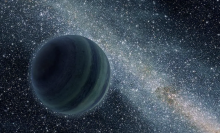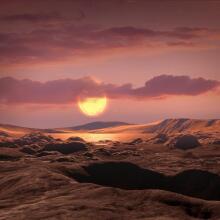When astronomers pointed the James Webb Space Telescope at the early universe, they found an ancient galaxy with an unusual light signature.
After a thorough study of the data, scientists determined stars within that galaxy aren't the direct culprit of its extraordinary brightness. It's space gas.
This finding, published in Monthly Notices of the Royal Astronomical Society, could provide a missing link in cosmic history, revealing a previously unknown phase of galaxy evolution — one in which superheated gas clouds can actually outshine their stars.
"It looks like these stars must be much hotter and more massive than what we see in the local universe," Harley Katz, an astrophysicist at the universities of Oxford in the United Kingdom and Chicago in the United States, said in a statement, "which makes sense because the early universe was a very different environment."

In astronomy, looking farther translates into observing the past because light and other forms of radiation take longer to reach us. Webb, a collaboration of NASA and its European and Canadian counterparts, was built to study an extremely early period of the cosmos, detecting invisible light at infrared wavelengths. In short, a lot of dust and gas in space obscures the view to extremely distant and inherently dim light sources, but infrared waves can penetrate through the clouds.
Webb has been able to observe some of the oldest, faintest light in existence, including this strange galaxy, GS-NDG-9422, as it existed 1 billion years after the Big Bang. For perspective, the universe’s age is estimated to be somewhere in the neighborhood of 13.8 billion years.
Scientists think the galaxy is undergoing intense star formation within a cocoon of dense gas that is churning out massive, hot stars. A barrage of light particles from the starlight could be bombarding the gas, causing it to shine extremely bright.
Tweet may have been deleted
Astronomers used computer models of hot, massive stars heating up clouds of gas. Not only did they demonstrate that the gas could be more luminous, but that the results closely replicated the recent telescope observations of galaxy GS-NDG-9422.
In the Milky Way’s neck of the universe, hot, massive stars generally have temperatures between 70,000 to 90,000 degrees Fahrenheit. But this galaxy has stars upward of 144,000 degrees Fahrenheit, the researchers said.
Cosmologists have predicted that gas could outshine stars in the environments of the universe’s first generation of stars, known as so-called Population III stars. Finding these pristine, pure-bred stars is one of the top priorities of modern astrophysics.
Given that most of the chemicals in the universe are thought to have come from exploded stars, scientists have rationalized that the firstborn must have been composed almost entirely of hydrogen and helium, the primitive material that emerged from the Big Bang. Over time, as stars died and enriched the universe with heavier chemical elements, subsequent generations of stars formed with more diverse ingredients.
Though the studied galaxy does not appear to have those highly-sought-after Population III stars — their light is too chemically complex — they seem to be something in between the universe’s first primitive stars and the kind that would likely inhabit more-established galaxies. Now the team wonders whether this is a common phenomenon among galaxies of this period.
"My first thought in looking at the galaxy’s [light] spectrum was, 'that’s weird,' which is exactly what the Webb telescope was designed to reveal," said lead author Alex Cameron of Oxford in a statement. It’s discovering "totally new phenomena in the early universe that will help us understand how the cosmic story began."
Topics NASA



















